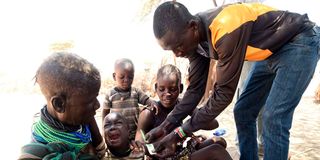How the warming planet is making more people sick

A man takes a picture of a cloud of smoke produced by burnt industrial waste in Athi River. Open burning of waste produces 11 per cent of global black carbon emissions.
What you need to know:
- Climate change is associated with health effects, which include increased respiratory and cardiovascular diseases, injuries and premature deaths related to extreme weather events, changes in the prevalence and geographical distribution of food and water-borne illnesses and other infectious diseases.
- The World Health Organization (WHO) reports that climate change is responsible for at least 150,000 deaths every year, a number that is expected to double by 2030. WHO highlights that between 2030 and 2050, climate change is expected to cause approximately 250 000 additional deaths annually from malnutrition, malaria, diarrhoea and heat stress.
Malaria-causing mosquitoes in the country have been flying high lately. Erstwhile, the tiny insects loved breeding in Kenya’s lowland areas, mostly in western, coastal and some parts of the Rift Valley. But lately, they are moving away from those regions and climate change is to blame.
At a recent conference organised by the Kenya Medical Research Institute (Kemri), scientists made public their study, which revealed that the climate crisis, especially the long dry spells, is pushing the female anopheles mosquitoes to the highlands; an area that had been alien to them.
In some parts of the country like the central region, most malaria cases are usually imported. This means that people diagnosed with the disease in such areas may have travelled from the endemic regions. The researchers, who published their findings in the scientific journal Biology Letters, combed through data from 1898 to 2016 and discovered that the female anopheles mosquito is moving away from the equator.
The damning outcome is that non-endemic regions in Kenya may soon start recording unique malaria cases.
Malaria is just one of the diseases but there are tonnes of other health impacts of climate change.
On the sidelines of the just-concluded Africa Health Agenda International Conference (AHAIC) that took place in Kigali, Rwanda, Dr Ahmed Ogwell, acting director of Africa CDC (The Centers for Disease Control and Prevention), said the effects of climate change are critical contributing factors to many of the health emergencies in the continent.
“Disasters such as flooding, drought or other extreme weather patterns have contributed to poorer health outcomes due to disruptions in health services, thus re-emergence of these diseases,” he said.
Dr Gitahi Githinji, Amref Health Africa’s chief executive, said climate change is one of the greatest threats to health systems in the continent.
“Climate change is associated with health effects, which include increased respiratory and cardiovascular diseases, injuries and premature deaths related to extreme weather events, changes in the prevalence and geographical distribution of food and water-borne illnesses and other infectious diseases,” he said.
The World Health Organization (WHO) reports that climate change is responsible for at least 150,000 deaths every year, a number that is expected to double by 2030. WHO highlights that between 2030 and 2050, climate change is expected to cause approximately 250 000 additional deaths annually from malnutrition, malaria, diarrhoea and heat stress.

Guyo Ibrae inspects carcasses of his livestock that died for lack of pasture sue to drought at Tigo village, Marsabit County, on February 10.
Climate change is the single biggest health threat facing humanity and health professionals worldwide are already responding to the health harms caused by this unfolding crisis.
Last year, the American Medical Association (AMA) declared climate change a public health crisis.
“This is an existential threat. We must continue to do everything we can to combat the climate crisis and act now to prevent catastrophic levels of global warming. Physicians pledge to do no harm and now it is time for the health sector to do the same by joining forces to commit to decarbonisation and public health,” said AMA Trustee Drayton Charles Harvey.
While no one is safe from these risks, the people whose health is being harmed first and worst by the climate crisis are those who contribute least to its causes, and who are least able to protect themselves and their families against it — people in low-income and disadvantaged countries and communities.
The Intergovernmental Panel on Climate Change (IPCC) predicts that sub-Saharan Africa will be at higher risk of enduring the health effects of climate change.
Mental health and climate change
In February last year, the IPCC affirmed that climate change is affecting people’s mental health. A study published in the scientific journal Plos Climate shows that mental health emanates from the economic, social, infrastructure, health, and food system disruptions triggered by weather and climate extremes.

In Africa, extreme heat has increased negative mental health outcomes and suicide risk.
“In Africa, extreme heat has increased negative mental health outcomes and suicide risk. Other weather extremes have increased anxiety, post-traumatic stress disorder (PTSD) and depression. In Asia, storms, floods, hurricanes, and cyclones have increased PTSD and depressive disorders; in Australasia, wildfires have led to mental health challenges; in Europe, flooding has negatively impacted mental health outcomes.
The study explains that people have either had mental health issues just by experiencing climate change or witnessing its impacts on the environment and humans in news.
“Even learning about climate change itself can affect mental health. The perceived threat of climate change can also lead to e anxiety and to anticipatory loss and grief related to climate change,” explains the study.
As people discuss climate adaptation in general, the study exemplifies ways in which people affected by mental health can adapt to it without its effect knocking them down.
The scientists suggest that governments should set aside funding, increase accountability, improve access to mental health care and programming, coordinate plan and implement issues to do with mental health linked to climate change.
They advise individuals to also have their own coping mechanisms. They ask people living in urban and peri-urban regions to consider having things like roof-top gardens as a way of practising agriculture.
“Embracing urban green and blue spaces and having active urban transport like walking and bicycling provides mental health co-benefits,” says the study. They say that having that in mind helps individuals improve food security, physical activity, social cohesion and wellbeing. The quality of air is also improved.
Heat waves
In their last month's report, the Kenya Meteorological Department projected that the current heat temperature of 32 degrees Celsius will be recorded in most parts of the country until mid-March this year.
Dr David Gikungu, the director of meteorological services, told Healthy Nation that since the rays are very strong from 11 am to 3pm in the afternoon, Kenyans and children in school should limit exposure to the sun during these hours.
“Spend more time under shade or indoors in well-ventilated buildings. Do not walk directly in the sun. Limit exposure to the sun during the hours. Sunburns significantly increase the lifetime risk of developing skin cancer, especially for children,” said Dr Gikungu.
In other countries like the United Kingdom and South Africa, people are already being diagnosed with heat-related diseases.
In Kenya, most hospitals, including Kenyatta National Hospital, are recording an influx of patients seeking treatment for heat-related issues such as rashes.
Apart from skin infections, heat waves cause illnesses such as heat exhaustion, heat stroke, hyperthermia, Rhabdomyolysis, heat cramps or the heat syncope (fainting episodes).
The IPCC indicates that prolonged periods of abnormally high temperatures can have serious health effects on vulnerable populations such as the elderly and the sick.
IPCC predicts that global warming will lead to hot days followed by nights of high temperatures.
Infectious, zoonotic and vector-borne diseases
A study by the scientific journal Nature shows that climate change can worsen the prevalence of certain diseases.
The study shows that warming leads to changes in habitats that lead to spillovers of viruses from animals to humans.
“Human pathogenic diseases can be aggravated by the broad array of climatic hazards triggered by our ongoing emission of greenhouse gases and include 58 per cent of all infectious diseases known to have impacted humanity in recorded history,” says the study
An editorial by the scientific journal Lancet highlighted how rising temperatures lead to a spike in infectious diseases.

A man with coronavirus at an intensive care unit.
“Climatic conditions are becoming increasingly suitable for the transmission of multiple infectious diseases, by directly affecting biological features of pathogens (growth, survival, and virulence) and their vectors, and by indirectly favouring transmission through the modification of ecosystems and changes in human behaviour,” they explained
In 2006, scientists attributed an outbreak of legionnaires' diseases — a bacterial lung infection in the United Kingdom — to climate change. The WHO also says that global warming will likely cause a major increase in insect-borne diseases in Europe. Countries like Azerbaijan, Tajikistan and Turkey might already be in the danger zone for mosquito-borne malaria caused by the changing climate.
Undernutrition
A new report released by Unicef this month highlights that Kenya is one of the 12 crisis-hit countries affected by nutrition issues. The failed rainy seasons in the country have greatly contributed to climate change.
The report shows that more than half of pregnant and breastfeeding women had moderate to severe food insecurity in 2021. Another group of women, the same figure, stopped eating at least one crucial food group
Globally, about one billion women and girls are undernourished and were found to be either underweight, short in stature, have micronutrient deficiencies or anaemia.

A child is screened for malnutrition at Kanamkuny village in Turkana by county health worker Paul Ekai.
The WHO, in its Climate and Health analysis for Kenya in 2016, had already warned that without considerable efforts made to improve climate resilience, malnutrition could increase by up to 20 per cent by 2050. Already, the number of malnourished women and girls has gone up by 25 per cent globally.
Food and water-borne diseases
Some of the food and waterborne diseases fuelled by climate change include cholera, salmonellosis and campylobacteriosis. While the diseases have been around in a long time, they have become more frequent with the erratic prolonged changes of weather.
Kenya is facing its worst drought in 40 years and the disaster is taking with it the country’s major water sources. Rivers are running dry, spreading misery and tension to millions of Kenyans whose fate now hangs in the balance.
One of the ripple effects for drought is the rise in cholera cases in the country. In December last year, WHO said climate change may likely worsen the cholera crisis in Africa.
A study published in the Proceedings of the National Academy of Sciences highlighting the relationship between rising temperatures and diarrhoeal disease in children under three years old revealed that weather anomalies known as precipitation shocks are associated with an increased risk of diarrhoea.
The unusually dry periods have grown increasingly common as the planet warms. Higher-than-normal temperatures contribute to an atmosphere that wavers between exceedingly moist and extremely dry.
The study found out that some parts of Africa are becoming even more parched; with researchers finding a strong correlation between these precipitation shocks and diarrhoea symptoms in young children.
“Climate change can influence the spread of pathogens anywhere. It becomes a critical public health risk when extended dry or wet periods occur in communities that lack essential sanitation infrastructure,” says the study.
The WHO estimates that in 2050, climate change could be responsible for approximately 32,954 additional diarrhoeal deaths worldwide among children aged 0–15 years.
To address this crisis, Dr Adelheid Onyango, the Director of Universal Health Coverage, WHO AFRO, said African governments have to integrate risk management and early warning systems.
“Governments should closely work with communities to find climate mitigation and adaptation solutions before focusing on complex technological remedies,” said Dr Onyango.
Respiratory illnesses
It starts with the root cause of climate change; the use of fossil fuels such as coal, oil and gas. A study conducted by Harvard University in collaboration with the University of Birmingham revealed that in 2018 alone, more than eight million people died from fossil fuel pollution. While this is a cause of climate change and not an impact, an article by the National Academies says that polluted air as a result of climate change leads to respiratory diseases.
“Spikes in ground-level ozone are linked with increased hospitalisations for chronic obstructive pulmonary disease (COPD), pneumonia, asthma, allergies and other lung problems. They are also associated with premature death,” said the article.
In Kenya, last month’s data from Kenyatta National Hospital shows that there were more than 100 patients in the outpatient department with illnesses related to respiratory infections.
A 2007 United Nations article indicated that people suffering from heart problems are susceptible to complications caused by increased temperatures since their cardiovascular system doubles its effort to keep their bodies cool.
The solutions
Dr Jeni Miller, executive director of Global Climate and Health Alliance, told Healthy Nation that governments have to be alive to the fact that climate change is more than just an energy issue but it also affects human health.
It is for this reason that Dr Miller advises countries to include health to their national climate policies.
At global conferences such as the United Nations Conference of Parties (COP), climate impacts on health barely get the attention they deserve.
Recently however, Dr Miller agrees that there has been progress but more can still be done. She says that plans are underway to headline Health during the 28th Conference of Parties (COP28), which will happen in the United Arab Emirates.

Climate change policy development and challenges need to be viewed through the lens of a particular place to have a context-specific approach.
“Only by explicitly addressing health and measuring health outcomes, then governments will ensure that they are going to deliver the maximum protections for people’s health,” she says.
She pinpoints that there’s an urgent need to phase out fossil fuels (such as coal, oil and gas), for it is not only a key driver for climate change but also affects people’s health.
“Investing in healthcare, public health systems, and sustainable food systems that deliver nutritious foods, in water and sanitation, and in clean energy access, to enable communities to develop and to be resilient,” she advised
“In addition, protecting people’s health means following through on funding to assist countries that are experiencing the most severe climate impacts and have the least resources to handle them. Addressing one of these areas of climate action – whether loss and damage, adaptation or mitigation – without the others is to fail to address the climate and health nexus,” she added.
Data is also a crucial tool that Dr Miller advises governments to embrace since it is crucial in understanding the change as well as preparing communities. Technology is also key to tackling the health impacts of climate change.
“This can range from establishing heat early warning systems and action plans, and worker protection policies; it could take the form of research to model and project new patterns of malaria and develop interventions,” she says.
“Health professionals and health workers also need to be trained in climate change impacts so that they recognise the problems their patients are experiencing, which might not have been prevalent previously,” she adds.
Despite most countries experiencing health impacts of climate change, Dr Miller believes that all hope is not lost.
“It is absolutely not too late to make critical changes that can make a massive difference. We have to quickly drive down greenhouse gas emissions, including fast-acting emissions like methane. The worst thing we can do is to become paralysed and give up. Every degree of warming averted will make a difference to people’s health,” she says.






